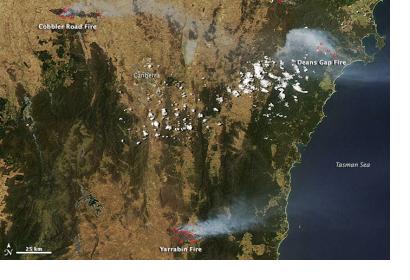United
Nations
Office for Outer Space Affairs
UN-SPIDER Knowledge Portal
The Moderate Resolution Imaging Spectroradiometer (MODIS) on NASA’s Aqua satellite captured an image showing the large bush fires burning in eastern New South Wales, Australia, on 9 January 2013. Red outlines indicate hot spots where MODIS detected unusually warm surface temperatures associated with fires.
Temperatures cooled somewhat in New South Wales on January 9, 2013, a day after record-breaking temperatures seared Australia’s most populous state on back-to-back days. Despite the reprieve, bush fires continued to rage throughout New South Wales and many other parts of the continent.
Extreme heat and strong winds have fueled the fires. Statistics released by Australia’s Bureau of Meteorology indicated that the average temperature across the country on Tuesday, 40°Celsius (104°Fahrenheit), was the highest ever recorded, exceeding a mark set just the day before. Australian meteorologists were even forced to add extra color bands to their forecast maps to represent the unusually high temperatures.
On 8 January 2013, Canadian astronaut Chris Hadfield had also captured these interesting snapshots of the wildfires in southeastern Australia from the International Space Station.
